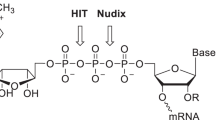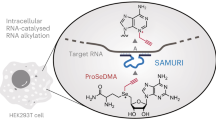Abstract
Biotin-labeled RNA has found broad applications in chemistry, biology and biomedicine. In this protocol, we describe a simple procedure for 5′ RNA biotin labeling by one-step in vitro transcription. A biotin–AMP (adenosine 5′-monophosphate) conjugate, biotin-HDAAMP (adenosine 5′-(6-aminohexyl) phosphoramide; where HDA is 1,6-hexanediamine), is chemically synthesized. Transcription initiation by biotin-HDAAMP under the T7 φ2.5 promoter produces 5′ biotin-labeled RNA with high labeling efficiency. The procedure is especially useful for biotin labeling of RNA that is larger than 60 nucleotides. In addition, the protocol provides an attractive alternative to chemical synthesis of biotin-labeled small RNA of less than 60 nucleotides, particularly when the desired quantity of RNA is low. The whole procedure, from chemical syntheses to isolated biotin-labeled RNA, can be completed within 2 weeks.
This is a preview of subscription content, access via your institution
Access options
Subscribe to this journal
Receive 12 print issues and online access
$259.00 per year
only $21.58 per issue
Buy this article
- Purchase on Springer Link
- Instant access to full article PDF
Prices may be subject to local taxes which are calculated during checkout











Similar content being viewed by others
References
Ha, T. et al. Ligand-induced conformational changes observed in single RNA molecules. Proc. Natl. Acad. Sci. USA 96, 9077–9082 (1999).
Zhuang, X. et al. A single-molecule study of RNA catalysis and folding. Science 288, 2048–2051 (2000).
Zhuang, X. et al. Correlating structural dynamics and function in single ribozyme molecules. Science 296, 1473–1476 (2002).
Blanchard, S.C., Kim, H.D., Gonzalez, R.L. Jr., Puglisi, J.D. & Chu, S. tRNA dynamics on the ribosome during translation. Proc. Natl. Acad. Sci. USA 101, 12893–12898 (2004).
Blanchard, S.C., Gonzalez, R.L., Kim, H.D., Chu, S. & Puglisi, J.D. tRNA selection and kinetic proofreading in translation. Nat. Struct. Mol. Biol. 11, 1008–1014 (2004).
Lee, T.H., Blanchard, S.C., Kim, H.D., Puglisi, J.D. & Chu, S. The role of fluctuations in tRNA selection by the ribosome. Proc. Natl. Acad. Sci. USA 104, 13661–13665 (2007).
Ptushkina, M., von der Haar, T., Karim, M.M., Hughes, J.M. & McCarthy, J.E. Repressor binding to a dorsal regulatory site traps human eIF4E in a high cap-affinity state. EMBO J. 18, 4068–4075 (1999).
von Der Haar, T., Ball, P.D. & McCarthy, J.E. Stabilization of eukaryotic initiation factor 4E binding to the mRNA 5′-Cap by domains of eIF4G. J. Biol. Chem. 275, 30551–30555 (2000).
Ptushkina, M. et al. A second eIF4E protein in Schizosaccharomyces pombe has distinct eIF4G-binding properties. Nucleic Acids Res. 29, 4561–4569 (2001).
Marsden, S., Nardelli, M., Linder, P. & McCarthy, J.E. Unwinding single RNA molecules using helicases involved in eukaryotic translation initiation. J. Mol. Biol. 361, 327–335 (2006).
Schwartz, A., Margeat, E., Rahmouni, A.R. & Boudvillain, M. Transcription termination factor rho can displace streptavidin from biotinylated RNA. J. Biol. Chem. 282, 31469–31476 (2007).
Bauman, J.G. & Bentvelzen, P. Flow cytometric detection of ribosomal RNA in suspended cells by fluorescent in situ hybridization. Cytometry 9, 517–524 (1988).
Giaid, A. et al. Non-isotopic RNA probes. Comparison between different labels and detection systems. Histochemistry 93, 191–196 (1989).
Smith, M.D., Triantafillou, S., Parker, A., Wikaningrum, R. & Coleman, M. A nonradioactive method of in situ hybridization that uses riboprobes and paraffin-embedded tissue and its combination with immunohistochemistry. Diagn. Mol. Pathol. 6, 34–41 (1997).
Furtado, L.M., Su, H., Thompson, M., Mack, D.P. & Hayward, G.L. Interactions of HIV-1 TAR RNA with Tat-derived peptides discriminated by on-line acoustic wave detector. Anal. Chem. 71, 1167–1175 (1999).
Minunni, M., Tombelli, S., Gullotto, A., Luzi, E. & Mascini, M. Development of biosensors with aptamers as bio-recognition element: the case of HIV-1 Tat protein. Biosens. Bioelectron. 20, 1149–1156 (2004).
Kirby, R. et al. Aptamer-based sensor arrays for the detection and quantitation of proteins. Anal. Chem. 76, 4066–4075 (2004).
Tombelli, S., Minunni, M., Luzi, E. & Mascini, M. Aptamer-based biosensors for the detection of HIV-1 Tat protein. Bioelectrochemistry 67, 135–141 (2005).
Collett, J.R. et al. Functional RNA microarrays for high-throughput screening of antiprotein aptamers. Anal. Biochem. 338, 113–123 (2005).
Cho, E.J., Collett, J.R., Szafranska, A.E. & Ellington, A.D. Optimization of aptamer microarray technology for multiple protein targets. Anal. Chim. Acta. 564, 82–90 (2006).
Bini, A., Centi, S., Tombelli, S., Minunni, M. & Mascini, M. Development of an optical RNA-based aptasensor for C-reactive protein. Anal. Bioanal. Chem. 390, 1077–1086 (2008).
Rouault, T.A., Hentze, M.W., Haile, D.J., Harford, J.B. & Klausner, R.D. The iron-responsive element binding protein: a method for the affinity purification of a regulatory RNA-binding protein. Proc. Natl. Acad. Sci. USA 86, 5768–5772 (1989).
Ravelet, C., Grosset, C. & Peyrin, E. Liquid chromatography, electrochromatography and capillary electrophoresis applications of DNA and RNA aptamers. J. Chromatogr. A 1117, 1–10 (2006).
Hutanu, D. & Remcho, V.T. Aptamers as molecular recognition elements in chromatographic separations. Adv. Chromatogr. 45, 173–196 (2007).
Nair, T.M., Myszka, D.G. & Davis, D.R. Surface plasmon resonance kinetic studies of the HIV TAR RNA kissing hairpin complex and its stabilization by 2-thiouridine modification. Nucleic Acids Res. 28, 1935–1940 (2000).
Liphardt, J., Onoa, B., Smith, S.B., Tinoco, I.J. & Bustamante, C. Reversible unfolding of single RNA molecules by mechanical force. Science 292, 733–737 (2001).
Tinoco, I. Jr., Li, P.T. & Bustamante, C. Determination of thermodynamics and kinetics of RNA reactions by force. Q. Rev. Biophys. 39, 325–360 (2006).
Chu, T.C., Twu, K.Y., Ellington, A.D. & Levy, M. Aptamer mediated siRNA delivery. Nucleic Acids Res. 34, e73 (2006).
Levy, M., Cater, S.F. & Ellington, A.D. Quantum-dot aptamer beacons for the detection of proteins. Chembiochem. 6, 2163–2166 (2005).
Liang, R.Q. et al. An oligonucleotide microarray for microRNA expression analysis based on labeling RNA with quantum dot and nanogold probe. Nucleic Acids Res. 33, e17 (2005).
Pitulle, C., Kleineidam, R.G., Sproat, B. & Krupp, G. Initiator oligonucleotides for the combination of chemical and enzymatic RNA synthesis. Gene 112, 101–105 (1992).
Huang, F., Wang, G., Coleman, T. & Li, N. Synthesis of adenosine derivatives as transcription initiators and preparation of 5′ fluorescein- and biotin-labeled RNA through one-step in vitro transcription. RNA 9, 1562–1570 (2003).
Langer, P.R., Waldrop, A.A. & Ward, D.C. Enzymatic synthesis of biotin-labeled polynucleotides: novel nucleic acid affinity probes. Proc. Natl. Acad. Sci. USA 78, 6633–6637 (1981).
Theissen, G., Richter, A. & Lukacs, N. Degree of biotinylation in nucleic acids estimated by a gel retardation assay. Anal. Biochem. 179, 98–105 (1989).
Steen, R., Dahlberg, A.E., Lade, B.N., Studier, F.W. & Dunn, J.J. T7 RNA polymerase directed expression of the Escherichia coli rrnB operon. EMBO J. 5, 1099–1103 (1986).
Forghani, B., Yu, G.J. & Hurst, J.W. Comparison of biotinylated DNA and RNA probes for rapid detection of varicella-zoster virus genome by in situ hybridization. J. Clin. Microbiol. 29, 583–591 (1991).
Williamson, D., Cann, M.J. & Hodgson, D.R. Synthesis of 5′-amino-5′-deoxyguanosine-5′-N-phosphoramidate and its enzymatic incorporation at the 5′-termini of RNA molecules. Chem. Commun. 5096–5098 (2007).
Kinoshita, Y., Nishigaki, K. & Husimi, Y. Fluorescence-, isotope- or biotin-labeling of the 5′-end of single-stranded DNA/RNA using T4 RNA ligase. Nucleic Acids Res. 25, 3747–3748 (1997).
Martin, G. & Keller, W. Tailing and 3′-end labeling of RNA with yeast poly(A) polymerase and various nucleotides. RNA 4, 226–230 (1998).
Rosemeyer, V., Laubrock, A. & Seibl, R. Nonradioactive 3′-end-labeling of RNA molecules of different lengths by terminal deoxynucleotidyltransferase. Anal. Biochem. 224, 446–449 (1995).
Matsuki, T., Ito, R., Yokogawa, T. & Nishikawa, K. Sequence analysis of low-molecular-weight RNAs by the use of non-radioactive labeling. Nucleic Acids Symp. Ser. 29, 75–76 (1993).
Milligan, J.F., Groebe, D.R., Witherell, G.W. & Uhlenbeck, O.C. Oligoribonucleotide synthesis using T7 RNA polymerase and synthetic DNA templates. Nucleic Acids Res. 15, 8783–8798 (1987).
Milligan, J.F. & Uhlenbeck, O.C. Synthesis of small RNAs using T7 RNA polymerase. Methods Enzymol. 180, 51–62 (1989).
Huang, F., Bugg, C.W. & Yarus, M. RNA-catalyzed CoA, NAD, and FAD synthesis from phosphopantetheine, NMN, and FMN. Biochemistry 39, 15548–15555 (2000).
Huang, F. Efficient incorporation of CoA, NAD and FAD into RNA by in vitro transcription. Nucleic Acids Res. 31, e8 (2003).
Moriyama, K., Kimoto, M., Mitsui, T., Yokoyama, S. & Hirao, I. Site-specific biotinylation of RNA molecules by transcription using unnatural base pairs. Nucleic Acids Res. 33, e129 (2005).
Hirao, I. et al. An unnatural hydrophobic base pair system: site-specific incorporation of nucleotide analogs into DNA and RNA. Nat. Methods 3, 729–735 (2006).
Zhang, L., Sun, L., Cui, Z., Gottlieb, R.L. & Zhang, B. 5′-Sulfhydryl-modified RNA: initiator synthesis, in vitro transcription, and enzymatic incorporation. Bioconjug. Chem. 12, 939–948 (2001).
Dunn, J.J. & Studier, F.W. Complete nucleotide sequence of bacteriophage T7 DNA and the locations of T7 genetic elements. J. Mol. Biol. 166, 477–535 (1983).
Pleiss, J.A., Derrick, M.L. & Uhlenbeck, O.C. T7 RNA polymerase produces 5′ end heterogeneity during in vitro transcription from certain templates. RNA 4, 1313–1317 (1998).
Helm, M., Brule, H., Giege, R. & Florentz, C. More mistakes by T7 RNA polymerase at the 5′ ends of in vitro-transcribed RNAs. RNA 5, 618–621 (1999).
Coleman, T.M., Wang, G. & Huang, F. Superior 5′ homogeneity of RNA from ATP-initiated transcription under the T7 phi 2.5 promoter. Nucleic Acids Res. 32, e14 (2004).
Li, N., Yu, C. & Huang, F. Novel cyanine–AMP conjugates for efficient 5′ RNA fluorescent labeling by one-step transcription and replacement of [gamma-32P]ATP in RNA structural investigation. Nucleic Acids Res. 33, e37 (2005).
Guo, S., Huang, F. & Guo, P. Construction of folate-conjugated pRNA of bacteriophage phi29 DNA packaging motor for delivery of chimeric siRNA to nasopharyngeal carcinoma cells. Gene Ther. 13, 814–820 (2006).
Delius, H., van Heerikhuizen, H., Clarke, J. & Koller, B. Separation of complementary strands of plasmid DNA using the biotin–avidin system and its application to heteroduplex formation and RNA/DNA hybridizations in electron microscopy. Nucleic Acids Res. 13, 5457–5469 (1985).
Chapman, K.B. & Szostak, J.W. Isolation of a ribozyme with 5′–5′ ligase activity. Chem. Biol. 2, 325–333 (1995).
Lohse, P.A. & Szostak, J.W. Ribozyme-catalysed amino-acid transfer reactions. Nature 381, 442–444 (1996).
Coleman, T.M. & Huang, F. RNA-catalyzed thioester synthesis. Chem. Biol. 9, 1227–1236 (2002).
Acknowledgements
This study was supported by a NASA grant NNX07AI98G. We thank Adam York for NMR characterization of biotin-HDAAMP. Previous members of our laboratory, Guocan Wang, Tricia Coleman and Na Li made contributions to the development of the current protocol.
Author information
Authors and Affiliations
Corresponding author
Rights and permissions
About this article
Cite this article
Huang, F., He, J., Zhang, Y. et al. Synthesis of biotin–AMP conjugate for 5′ biotin labeling of RNA through one-step in vitro transcription. Nat Protoc 3, 1848–1861 (2008). https://doi.org/10.1038/nprot.2008.185
Published:
Issue Date:
DOI: https://doi.org/10.1038/nprot.2008.185
This article is cited by
-
MAPCap allows high-resolution detection and differential expression analysis of transcription start sites
Nature Communications (2019)
Comments
By submitting a comment you agree to abide by our Terms and Community Guidelines. If you find something abusive or that does not comply with our terms or guidelines please flag it as inappropriate.



